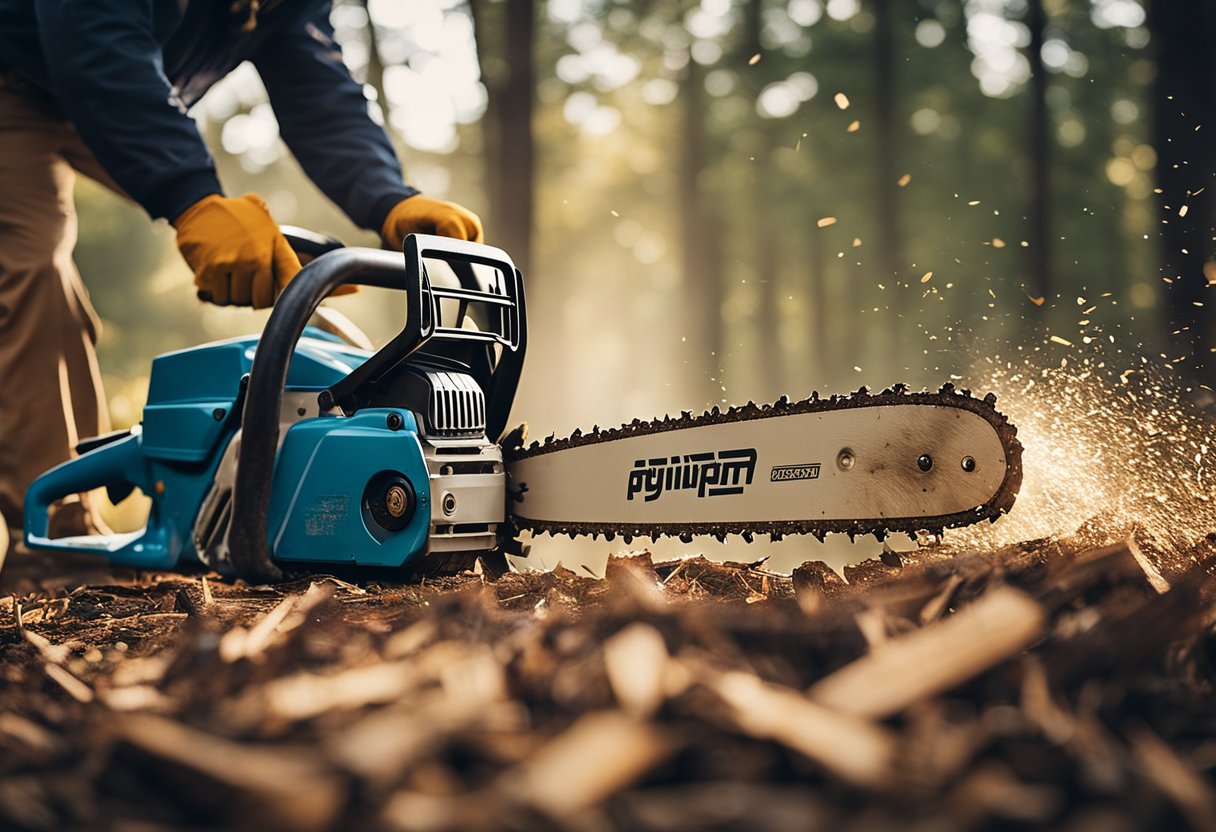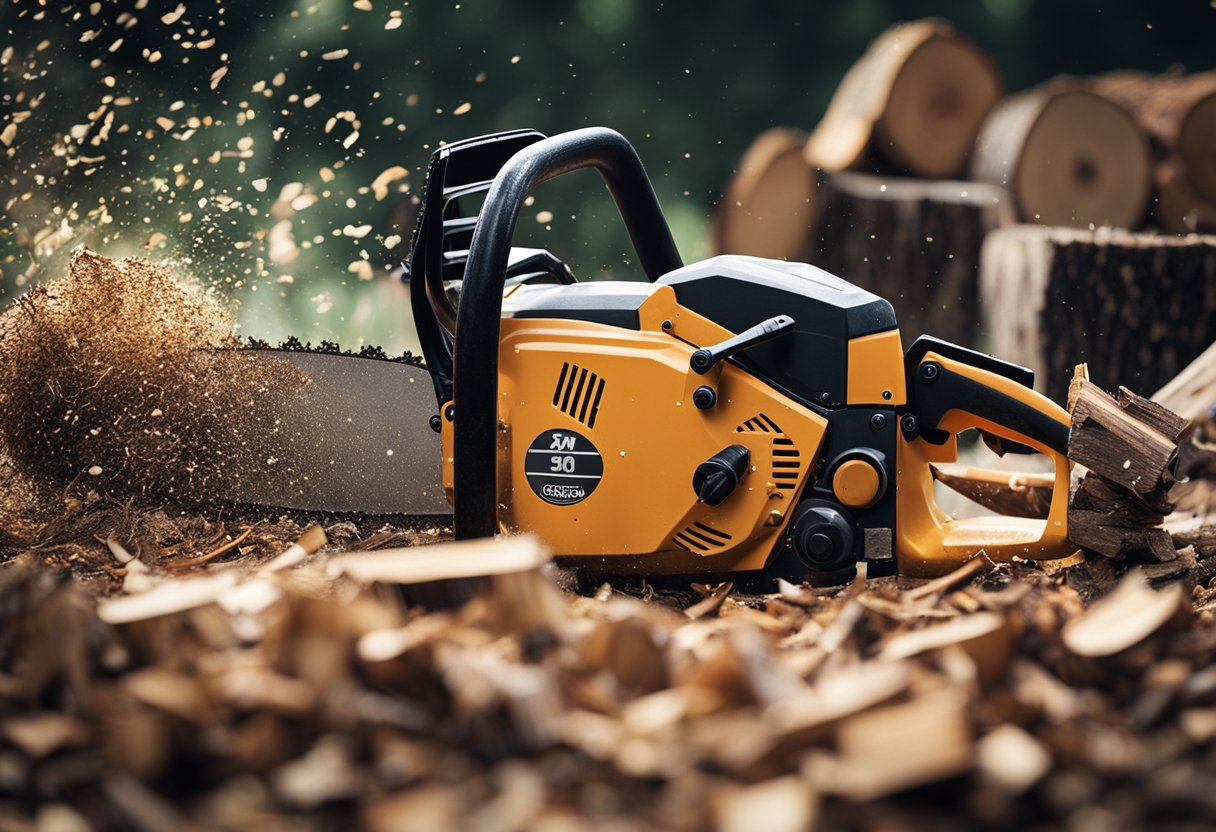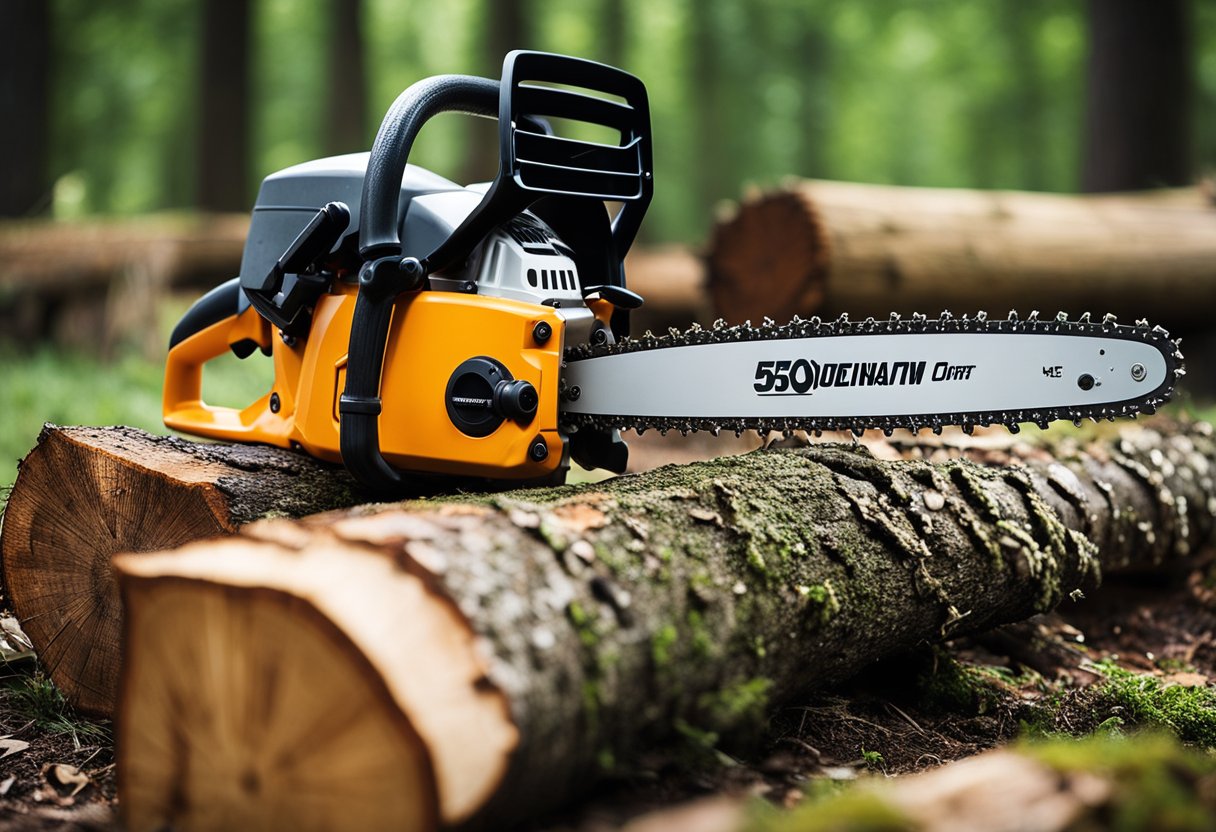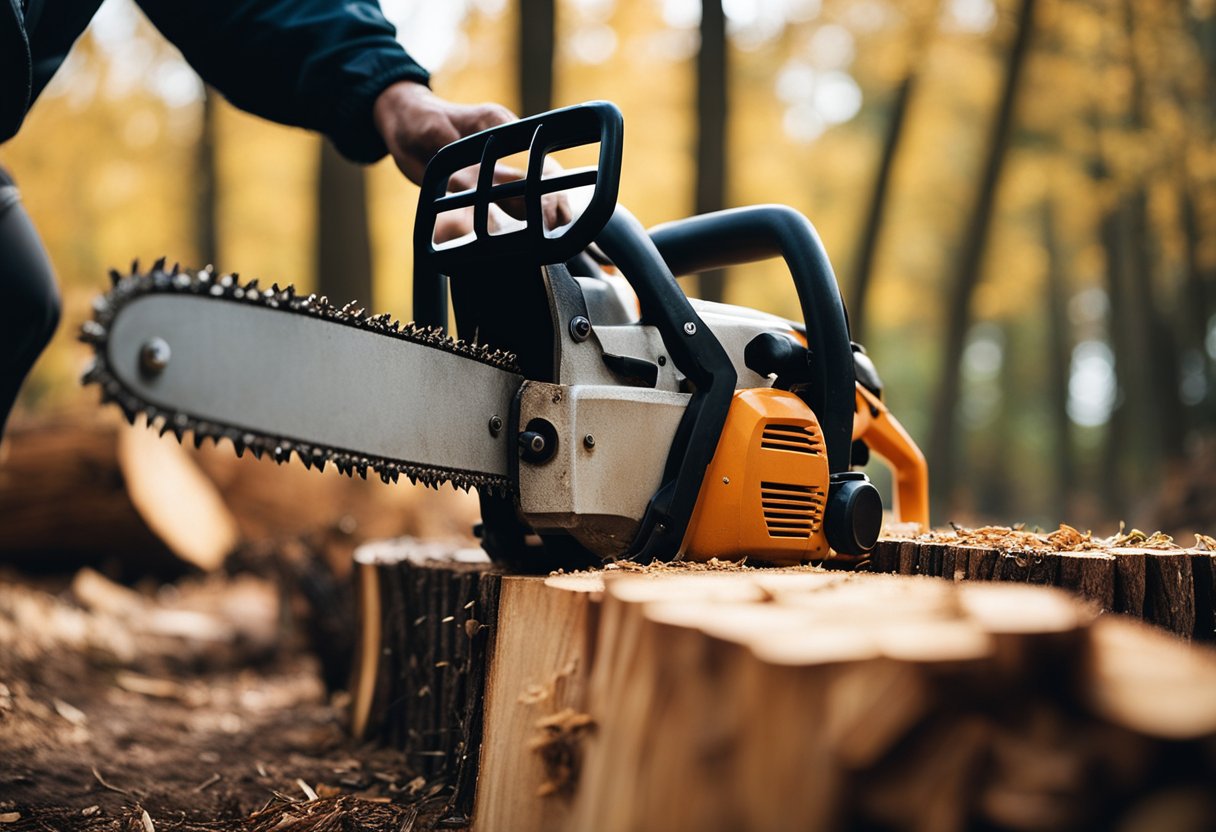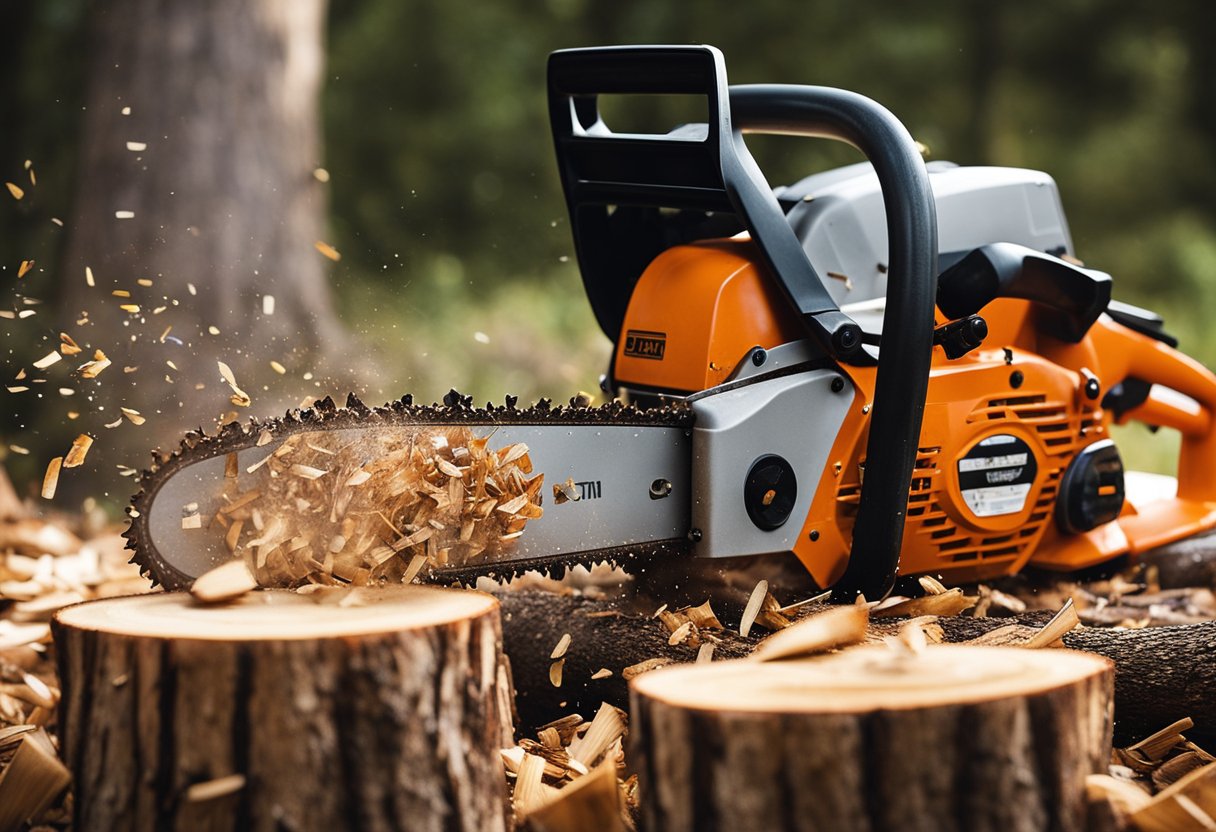Removing a tree stump can be a daunting task, but with the right tools and techniques, it can be done efficiently and safely. One of the most effective ways to remove a stump is by using a chainsaw. Chainsaws are powerful tools that can make quick work of even the toughest stumps, but they can also be dangerous if not used properly.
Before starting the cutting process, it is important to ensure that you have all the necessary equipment and have taken the proper safety measures. This includes wearing appropriate protective gear, such as gloves, eye and ear protection, and sturdy boots. You should also make sure that the chainsaw is in good working condition and that you have the right type of chainsaw chain for cutting stumps. Additionally, you should prepare the area around the stump by removing any debris or obstacles that could interfere with the cutting process.
Key Takeaways
- Proper preparation and safety measures are essential before starting the cutting process.
- Chainsaws are powerful tools that can make quick work of even the toughest stumps.
- Post-removal clean up and regular maintenance of the chainsaw are important for safety and longevity.
Necessary Equipment
https://www.youtube.com/watch?v=br9p3FnhdrU&embed=true
When it comes to removing a stump with a chainsaw, you will need some essential equipment to get the job done safely and effectively. Here are the necessary items you will need:
Personal Protective Equipment (PPE)
First and foremost, you must wear personal protective equipment (PPE) to protect yourself from injury. PPE includes gloves, a helmet, safety glasses, and chainsaw chaps or pants. These items will protect your hands, head, eyes, and legs from flying debris and other hazards.
Chainsaw
A chainsaw is the primary tool you will need to remove a stump. Choose a chainsaw with a bar length that is appropriate for the size of the stump you are removing. A chainsaw with a longer bar length will be able to cut through larger stumps more easily.
Shovel, Ax, and Mattock
You will need a shovel, ax, and mattock to dig around the stump and loosen the roots. Use the ax to cut through any large roots that you cannot remove with the mattock.
Root Saw
If the roots are too thick to cut with an ax, you may need a root saw. A root saw is a specialized saw designed to cut through thick roots.
Winch or Stump Puller
If the stump is too large to remove by hand, you may need a winch or stump puller. These tools will help you pull the stump out of the ground once you have cut through all the roots.
By having all the necessary equipment, you can remove a stump with a chainsaw safely and effectively. Remember to wear your PPE at all times and follow the manufacturer’s instructions for operating your chainsaw.
Preparation Before Starting
Before starting the process of removing a tree stump with a chainsaw, it is important to prepare the area to ensure safety and efficiency. Here are some steps to follow:
1. Assess the Stump and Surrounding Area
Before starting, take a good look at the stump and the surrounding area. Determine the size of the stump and the extent of the root system. This will help you plan your cuts and avoid potential hazards.
2. Clear the Area
Clear the area around the stump of any debris, rocks, or other obstacles that may interfere with your work. If the stump is close to a building or other structures, create a barrier to prevent any debris from flying into them.
3. Dig Around the Stump
Use a shovel to dig around the stump and expose the roots. This will make it easier to cut the roots with the chainsaw. Be careful not to damage any nearby plants or structures.
4. Expose the Roots
Expose as much of the root system as possible. Cut away any smaller roots with pruning shears or loppers. This will make it easier to cut the larger roots with the chainsaw.
5. Wear Protective Gear
Wear protective gear, including eye protection, ear protection, gloves, and sturdy footwear. This will protect you from flying debris and help prevent injuries.
By following these preparation steps, you will be able to safely and efficiently remove a tree stump with a chainsaw.
Safety Measures
As someone who has removed stumps with a chainsaw before, I know firsthand how dangerous it can be. That’s why it’s essential to take proper safety measures to minimize the risks involved. Here are a few safety tips that I recommend:
- Wear protective clothing such as gloves, eye protection, and ear protection. Chainsaws can produce a lot of noise, so hearing protection is a must.
- Wear steel-toed boots to protect your feet from falling branches or debris.
- Keep the chainsaw blade sharp and properly lubricated. A dull blade can cause kickback, which is when the chainsaw suddenly jerks back towards you and can cause serious injuries.
- Maintain a safe distance from the chainsaw blade. Never stand directly behind the saw or to the side of the cutting bar.
- Ensure that the chainsaw chain brake is engaged when the chainsaw is not in use. This will prevent the chain from moving accidentally.
It’s important to note that removing a stump with a chainsaw can be risky, so it’s best to hire a professional if you’re not comfortable doing it yourself. However, if you do decide to do it yourself, make sure you follow these safety measures to minimize the risks involved.
Cutting Process
https://www.youtube.com/watch?v=ESoJG_sN6t4&embed=true
Once I have prepared the area and ensured safety measures, I begin the cutting process to remove the stump with my chainsaw. The cutting process involves several steps, including cutting the stump, cutting tree roots, and making horizontal cuts.
First, I start by cutting the stump as close to the ground as possible. For larger stumps, I may need to make several cuts to remove the entire stump. I make sure to use the appropriate chain and bar size for the job to ensure efficiency and safety.
Next, I cut the tree roots around the stump. I use a shovel or digging bar to expose the roots, and then I cut them with my chainsaw. It is important to cut the roots as close to the stump as possible to ensure that the entire root system is removed.
After cutting the roots, I make horizontal cuts into the stump. I start at the top of the stump and work my way down, making cuts about 1 to 2 inches apart. These cuts help to break up the stump and make it easier to remove.
Once I have made the horizontal cuts, I use a pry bar or shovel to rock the stump back and forth until it becomes loose. Finally, I remove the stump and fill the hole with soil.
Overall, the cutting process is essential for successful chainsaw stump removal. By cutting the stump, cutting tree roots, and making horizontal cuts, I can effectively remove the stump and ensure that the area is safe and ready for further landscaping.
Stump Removal Methods
https://www.youtube.com/watch?v=cHIc3T3cbGc&embed=true
When it comes to removing a tree stump, there are several methods available. Each method has its own advantages and disadvantages, and the best method for you will depend on your specific situation. In this section, I will discuss some of the most common stump removal methods.
Grinding
One of the most popular methods for removing a tree stump is grinding. A stump grinder is a machine that grinds the stump into small pieces, making it easier to remove. Stump grinding is an efficient and effective method, and it is also environmentally friendly. However, it can be expensive, and it requires some skill to operate the machine.
Chemical Method
Another method for removing a tree stump is the chemical method. This involves using a stump remover chemical to break down the stump over time. This method is relatively cheap and easy, but it can take several months for the stump to fully decay. Additionally, the chemicals used can be harmful to the environment.
Burning
Burning the stump is another option for removal. This involves using kerosene or another flammable liquid to ignite the stump and burn it down. This method is relatively cheap and easy, but it can be dangerous and is not recommended in areas with high fire risk.
Digging
Finally, digging is another option for removing a tree stump. This involves using a shovel or other digging tool to dig around the stump and remove it from the ground. This method is cheap and easy, but it can be time-consuming and labor-intensive.
In conclusion, there are several methods available for removing a tree stump, each with its own advantages and disadvantages. Grinding is an efficient and effective method, while the chemical method is cheap and easy. Burning can be dangerous, and digging is labor-intensive. Choose the method that best suits your needs and situation.
Post-Removal Clean Up
After removing the stump with a chainsaw, it is important to clean up the area properly to avoid any accidents or injuries. Here are a few steps that I follow to ensure a safe and clean post-removal process:
Clearing Debris
The first step is to clear all the debris around the stump. Use a rake or a broom to sweep away any wood chips, sawdust, or small branches that may have fallen around the area. This will make it easier to see the hole that has been left behind after removing the stump.
Filling the Hole
The next step is to fill the hole with soil. It is important to fill the hole with soil to prevent any accidents and to maintain the aesthetics of your yard. Use a shovel to fill the hole with soil and compact it using your foot. Keep adding soil until the hole is completely filled.
Planting Grass Seed
If the stump was in an area that you want to keep grassy, then you should consider planting grass seed. This will help to cover up the area and make it look more attractive. Spread the grass seed evenly over the soil and water it well. Keep watering the area regularly until the grass seed has germinated and grown to a sufficient height.
Watering
After filling the hole with soil and planting grass seed, it is important to water the area thoroughly. This will help to settle the soil and ensure that the grass seed germinates properly. Water the area well and keep watering it regularly until the grass has grown to a sufficient height.
By following these simple steps, you can ensure that the area around the stump is safe and clean. Remember to always wear protective gear when working with a chainsaw and to follow all safety precautions to avoid any accidents or injuries.
Maintenance of Chainsaw
https://www.youtube.com/watch?v=c1eiXLx5pFQ&embed=true
As someone who has used a chainsaw to remove stumps, I understand the importance of maintaining the tool. Regular maintenance of the chainsaw not only ensures the longevity of the tool but also keeps it safe to use. Here are a few key maintenance tips for your chainsaw:
1. Clean the Chainsaw Regularly
Cleaning the chainsaw after every use is essential to keep it running smoothly. The sawdust and debris can accumulate in the chainsaw’s air filter, carburetor, and spark plug, causing the chainsaw to malfunction or even fail. Use a brush or compressed air to remove the sawdust and debris from the chainsaw’s body, and clean the air filter with soap and water.
2. Check the Chainsaw Chain Tension
The chainsaw chain needs to be tight enough to cut efficiently but not too tight that it puts strain on the chainsaw. Check the chain tension before every use, and adjust it if necessary. A loose chain can slip off the chainsaw’s bar, while a tight chain can damage the chainsaw’s engine.
3. Sharpen the Chainsaw Chain
A dull chainsaw chain can be dangerous to use, as it can cause the chainsaw to kickback. Sharpen the chainsaw chain regularly using a chainsaw file or a chainsaw sharpener. If you don’t have experience sharpening a chainsaw chain, it’s best to take it to a professional.
4. Replace the Chainsaw Chain and Bar
The chainsaw chain and bar can wear out over time, especially if you use the chainsaw regularly. Replace the chainsaw chain and bar when you notice signs of wear and tear, such as a loose chain or a bent bar. It’s important to use the right chain and bar size for your chainsaw, as using the wrong size can cause the chainsaw to malfunction.
By following these maintenance tips, you can ensure that your chainsaw is always in top condition and ready to use. Remember that safety should always come first when using a chainsaw, so wear appropriate protective gear and follow the manufacturer’s instructions.
Potential Challenges
Removing a stump with a chainsaw can be a challenging task, especially if the stump is large or thick. It can also be labor-intensive, requiring manual labor to dig around the stump and expose its roots. However, with the right tools and techniques, it is possible to remove a stump efficiently and safely.
One potential challenge when removing a stump is the presence of pests. Stumps can be a breeding ground for insects and other pests, which can spread to nearby plants and trees. It’s important to take steps to prevent pests from infesting the stump, such as covering it with a tarp or treating it with insecticide.
Another challenge when removing a stump is breaking through the tough roots. Thick tree stumps can have roots that extend deep into the ground, making them difficult to remove. In some cases, it may be necessary to use a root saw or other specialized tool to cut through the roots.
The appearance of the area after the stump is removed is also a consideration. Stump removal can leave a large hole in the ground, which can be unsightly and pose a tripping hazard. To address this, it may be necessary to fill the hole with soil or gravel and plant grass or other ground cover.
Finally, it’s important to consider the environmental impact of stump removal. Chainsaws can be noisy and emit exhaust fumes, which can be harmful to the environment. It’s important to use a chainsaw that meets emissions standards and take steps to minimize noise pollution, such as working during daylight hours and avoiding using the chainsaw near residential areas.
Frequently Asked Questions
https://www.youtube.com/watch?v=OJ1e-d4gX8A&embed=true
What is the easiest way to remove a stump?
The easiest way to remove a stump is by using a chainsaw. First, cut the stump as close to the ground as possible. Then, use a shovel to dig around the stump and expose the roots. Finally, use the chainsaw to cut the roots and remove the stump.
What is the best tool for cutting tree stumps?
The best tool for cutting tree stumps is a chainsaw. Chainsaws are powerful and can cut through even the toughest of stumps. However, it is important to use the right size chainsaw for the job.
How do you cut a tree trunk with a chainsaw?
To cut a tree trunk with a chainsaw, first, make sure the tree is stable and won’t fall. Then, make a horizontal cut on one side of the trunk, followed by a horizontal cut on the other side. Finally, make a vertical cut that connects the two horizontal cuts, and the tree trunk will fall.
Can you cut tree roots with a chainsaw?
Yes, you can cut tree roots with a chainsaw. However, it is important to be careful when doing so, as cutting the wrong roots can cause the tree to fall. It is best to consult with a professional if you are unsure.
How to remove a stump by hand?
Removing a stump by hand can be a difficult and time-consuming process. First, use a shovel to dig around the stump and expose the roots. Then, use an axe or saw to cut the roots. Finally, use a pry bar to remove the stump from the ground.
Stump removal cost?
The cost of stump removal varies depending on the size of the stump and the method used to remove it. On average, stump removal can cost anywhere from $60 to $350. It is best to consult with a professional to get an accurate estimate.

Hi, I’m Sal Muller of Tooltrip.com. My DIY experience led me to understand essential power tools for home projects. Tooltrip.com guides enthusiasts and professionals in choosing right tools for any job. I provide concise top tool reviews for easier, efficient DIY.

